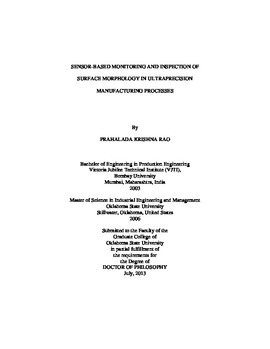| dc.contributor.advisor | Bukkapatnam, Satish T. S. | |
| dc.contributor.author | Rao, Prahalad Krishna | |
| dc.date.accessioned | 2014-09-24T14:17:03Z | |
| dc.date.available | 2014-09-24T14:17:03Z | |
| dc.date.issued | 2013-07 | |
| dc.identifier.uri | https://hdl.handle.net/11244/11037 | |
| dc.description.abstract | This research proposes approaches for monitoring and inspection of surface morphology with respect to two ultraprecision/nanomanufacturing processes, namely, ultraprecision machining (UPM) and chemical mechanical planarization (CMP). The methods illustrated in this dissertation are motivated from the compelling need for in situ process monitoring in nanomanufacturing and invoke concepts from diverse scientific backgrounds, such as artificial neural networks, Bayesian learning, and algebraic graph theory. From an engineering perspective, this work has the following contributions: | |
| dc.description.abstract | 1. A combined neural network and Bayesian learning approach for early detection of UPM process anomalies by integrating data from multiple heterogeneous in situ sensors (force, vibration, and acoustic emission) is developed. The approach captures process drifts in UPM of aluminum 6061 discs within 15 milliseconds of their inception and is therefore valuable for minimizing yield losses. | |
| dc.description.abstract | 2. CMP process dynamics are mathematically represented using a deterministic multi-scale hierarchical nonlinear differential equation model. This process-machine inter-action (PMI) model is evocative of the various physio-mechanical aspects in CMP and closely emulates experimentally acquired vibration signal patterns, including complex nonlinear dynamics manifest in the process. By combining the PMI model predictions with features gathered from wirelessly acquired CMP vibration signal patterns, CMP process anomalies, such as pad wear, and drifts in polishing were identified in their nascent stage with high fidelity (R2 ~ 75%). | |
| dc.description.abstract | 3. An algebraic graph theoretic approach for quantifying nano-surface morphology from optical micrograph images is developed. The approach enables a parsimonious representation of the topological relationships between heterogeneous nano-surface features, which are enshrined in graph theoretic entities, namely, the similarity, degree, and Laplacian matrices. Topological invariant measures (e.g., Fiedler number, Kirchoff index) extracted from these matrices are shown to be sensitive to evolving nano-surface morphology. For instance, we observed that prominent nanoscale morphological changes on CMP processed Cu wafers, although discernible visually, could not be tractably quantified using statistical metrology parameters, such as arithmetic average roughness (Sa), root mean square roughness (Sq), etc. In contrast, CMP induced nanoscale surface variations were captured on invoking graph theoretic topological invariants. Consequently, the graph theoretic approach can enable timely, non-contact, and in situ metrology of semiconductor wafers by obviating the need for reticent profile mapping techniques (e.g., AFM, SEM, etc.), and thereby prevent the propagation of yield losses over long production runs. | |
| dc.format | application/pdf | |
| dc.language | en_US | |
| dc.rights | Copyright is held by the author who has granted the Oklahoma State University Library the non-exclusive right to share this material in its institutional repository. Contact Digital Library Services at lib-dls@okstate.edu or 405-744-9161 for the permission policy on the use, reproduction or distribution of this material. | |
| dc.title | Sensor-based monitoring and inspection of surface morphology in ultraprecision manufacturing processes | |
| dc.contributor.committeeMember | Case, Kenneth E. | |
| dc.contributor.committeeMember | Kolarik, William J. | |
| dc.contributor.committeeMember | Lucca, Don A. | |
| dc.contributor.committeeMember | Kong, Zhenyu (James) | |
| osu.filename | Rao_okstate_0664D_12968.pdf | |
| osu.accesstype | Open Access | |
| dc.type.genre | Dissertation | |
| dc.type.material | Text | |
| thesis.degree.discipline | Industrial Engineering and Management | |
| thesis.degree.grantor | Oklahoma State University | |
